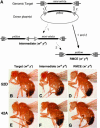Site-specific transformation of Drosophila via phiC31 integrase-mediated cassette exchange
- PMID: 16547094
- PMCID: PMC1526508
- DOI: 10.1534/genetics.106.056945
Site-specific transformation of Drosophila via phiC31 integrase-mediated cassette exchange
Abstract
Position effects can complicate transgene analyses. This is especially true when comparing transgenes that have inserted randomly into different genomic positions and are therefore subject to varying position effects. Here, we introduce a method for the precise targeting of transgenic constructs to predetermined genomic sites in Drosophila using the C31 integrase system in conjunction with recombinase-mediated cassette exchange (RMCE). We demonstrate the feasibility of this system using two donor cassettes, one carrying the yellow gene and the other carrying GFP. At all four genomic sites tested, we observed exchange of donor cassettes with an integrated target cassette carrying the mini-white gene. Furthermore, because RMCE-mediated integration of the donor cassette is necessarily accompanied by loss of the target cassette, we were able to identify integrants simply by the loss of mini-white eye color. Importantly, this feature of the technology will permit integration of unmarked constructs into Drosophila, even those lacking functional genes. Thus, C31 integrase-mediated RMCE should greatly facilitate transgene analysis as well as permit new experimental designs.
Figures




References
-
- Baer, A., and J. Bode, 2001. Coping with kinetic and thermodynamic barriers: RMCE, an efficient strategy for the targeted integration of transgenes. Curr. Opin. Biotechnol. 12: 473–480. - PubMed
-
- Belteki, G., M. Gertsenstein, D. W. Ow and A. Nagy, 2003. Site-specific cassette exchange and germline transmission with mouse ES cells expressing phiC31 integrase. Nat. Biotechnol. 21: 321–324. - PubMed
-
- Bouhassira, E. E., K. Westerman and P. Leboulch, 1997. Transcriptional behavior of LCR enhancer elements integrated at the same chromosomal locus by recombinase-mediated cassette exchange. Blood 90: 3332–3344. - PubMed
-
- Brand, A. H., and N. Perrimon, 1993. Targeted gene expression as a means of altering cell fates and generating dominant phenotypes. Development 118: 401–415. - PubMed
Publication types
MeSH terms
Substances
Grants and funding
LinkOut - more resources
Full Text Sources
Other Literature Sources
Molecular Biology Databases
Research Materials

